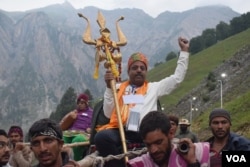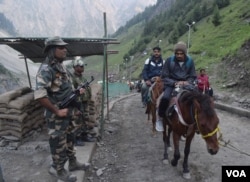Amid concern and tight safety, a 43-day annual Amarnath Yatra — a Hindu pilgrimage to a cave situated 3,888 meters above sea stage — is underway in India-administered Kashmir after a spot of three years.
Over half 1,000,000 pilgrims are anticipated to participate on this 12 months’s Yatra, which started on June 30. In line with the most recent reviews, about 50,000 pilgrims visited the holy shrine throughout the first few days, defying nervousness over the low-intensity insurgency within the Muslim-majority area.
Authorities count on a spike within the variety of pilgrims this 12 months due to pent-up demand. The Yatra was canceled in 2019 amid widespread lockdowns after the Indian authorities abruptly revoked the areas’ semi-autonomous standing on August 5 of that 12 months. The COVID-19 pandemic pressured the occasion to be postponed in 2020 and 2021.
“Sadly, I used to be not in a position to come as a result of COVID lockdown” for these two years, stated Mansih Jatt, a Hindu devotee who’s on his fourth go to to the cave. “It’s a pleasure to see the resumption of Yatra once more with higher safety and higher amenities.”
Safety beefed up
In view of the safety threats, the federal government of India has deployed military and paramilitary forces together with the Jammu and Kashmir Police and State Catastrophe Response Pressure groups on the principle routes utilized by pilgrims on their strategy to the cave.
In line with the South Asian Terrorism Portal — a database monitoring terrorism and low-intensity warfare in South Asia — 33 people recognized as terrorists have been killed within the Kashmir area in June, the very best whole for any month this 12 months. The area has additionally seen a latest spike in focused killings, together with some aimed on the minority Hindu group.
However the heavy safety preparations are offering consolation to the pilgrims.
“I’m pleased to see how the federal government has supplied safety to us from Jammu to the Holy Cave,” stated Pravesh Kumar Bal, a pilgrim from the Indian state of Uttar Pradesh. “Earlier, we have been fearful of coming right here, as militant outfits had warned safety businesses of attacking Yatris, however seemingly, this place is peaceable and protected.”
The a number of layers of safety for the pilgrims embrace drone surveillance, radio frequency identification and a whole bunch of latest CCTV cameras along with these already in place.
Jammu and Kashmir Lieutenant Governor Manoj Sinha instructed the media on Sunday, “Safety forces have coordinated in a greater approach, and I can say that among the best preparations relating to safety are in place and by the grace of God, the whole lot is happening effectively.”
Enterprise: acquire or loss?
The pilgrimage offers an necessary supply of revenue for native companies and others who present the guests with meals, lodging, souvenirs and different facilities.
“Final three years have been extraordinarily horrible for us to outlive,” stated Imitiyaz Ahmed Reshi, a resident of Srinagar who offers tent lodging to the pilgrims. “Our companies instantly relied on Yatra. I hope that this 12 months Yatra will find yourself peacefully.”
The Kashmir Chamber of Commerce and Trade, a neighborhood commerce group, calculates that the three years of lockdowns and cancellations have value the area $7 billion.
Zakir Ahmed, who presents a service that transports pilgrims utilizing small horses or ponies, instructed VOA, “We confronted myriad issues from the final two years as the federal government suspended Yatra. Now, everybody right here is pleased — pony wallas, tent suppliers and shopkeepers. We hope this 12 months we might earn sufficient to handle our dwelling.”
Nonetheless, the unprecedented safety preparations have irked some shopkeepers, vacationers, fruit growers and tourism service suppliers who make their dwelling from trekkers and different guests not related to the pilgrimage.
Rauf Tramboo, the president of Journey Tour Operators Affiliation of Kashmir, instructed VOA his affiliation members are annoyed that many common mountaineering routes have been closed throughout the Yatra, disrupting the three- to four-month trekking season from June to September.
“We’ve got taken advance reserving from vacationers who have been supposed to return right here for mountaineering however resulting from inaccessibility of the monitoring areas within the valley, over 3,000 trekkers have canceled their journeys. We’ve got suffered an enormous loss,” he stated.
Everybody within the Kashmir Valley’s tourism commerce understands the safety issues, he famous. Tramboo added, although, that “the federal government might have knowledgeable us effectively prematurely in order that we would not have taken any reserving for the Yatra days.”
Farooq Kuthoo, president of the Journey Brokers Affiliation of Kashmir, stated he has been receiving each day calls from distressed vacationers who’re upset at being barred from some common locations.
“The federal government mustn’t discriminate between leisure and pilgrimage tourism,” he stated.
There are additionally reviews of vans being halted on the Srinagar-Jammu Nationwide Freeway, which connects Jammu with the Kashmir Valley and is the principle Yatra route. Fruit growers in north Kashmir’s Sopore space held a protest Saturday towards the halting of vans.
Yet one more menace is posed by the COVID-19 pandemic, which has seen a latest surge with greater than 16,000 new instances throughout India and 24 deaths on Sunday alone. The variety of each day new instances in Jammu and Kashmir rose from 19 to 74 within the two weeks by Saturday.
In anticipation of medical emergencies, medical doctors and paramedics have been deployed. Additionally, two 50-bed hospitals have been arrange by the Protection Analysis and Growth Group with the funds supplied by India’s Ministry of Well being and Household Welfare.
Wasim Nabi contributed to this text.





